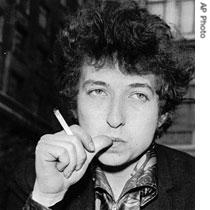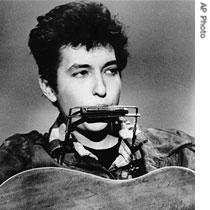VOA慢速英语-THIS IS AMERICA - Bob Dylan: His Musical Roots, and
时间:2019-01-06 作者:英语课 分类:VOA慢速英语2008年(六)月
In the ‘60s he was a wildly popular folk singer. But his musical journey took him beyond the music his fans expected him to play. First of two parts. Transcript 1 of radio broadcast:
08 June 2008
VOICE ONE:
Welcome to THIS IS AMERICA in VOA Special English. I'm Steve Ember.
VOICE TWO:
And I'm Barbara Klein. Today we have the first of two programs about one of America's greatest musical and lyrical minds. This singer and songwriter recently won a special Pulitzer Prize. The prize committee said works of "extraordinary poetic 2 power" mark his influence on popular music and American culture.
VOICE ONE:

1965: Singer Bob Dylan in London
The artist is Bob Dylan.
(MUSIC)
VOICE TWO:
The nineteen sixties were a time of great social change. Bob Dylan was called the voice of his generation. Yet he rejected that idea, and his musical journey has taken him beyond the music his fans expected him to play.
His most recent album, "Modern Times," was released in two thousand six. It became his first number one album in thirty years.
(MUSIC)
VOICE ONE:
Bob Dylan was born Robert Allen Zimmerman. He was born on May twenty-fourth, nineteen forty-one, in Duluth, Minnesota, in the Midwest. When he was young, his father became sick with polio. As a result, his family moved to the small town of Hibbing, Minnesota. His family was part of a small Jewish community there.
In high school, the young Robert Zimmerman started his own musical groups. These included the Shadow Blasters and the Golden Chords. He played popular rock and roll songs. He especially liked the music of Little Richard.
VOICE TWO:
In nineteen fifty-nine, he went to Minneapolis to attend the University of Minnesota. He left college after one year, but in Minneapolis he became interested in folk music. Here is a recording 3 of him from nineteen sixty, playing a version of the folk song "Rambler, Gambler."
(MUSIC)
It was also in Minneapolis that he started calling himself Bob Dylan. In his book "Chronicles" he writes that he wanted to call himself Robert Allyn. But then he saw some poems by the Welsh poet Dylan Thomas, and that settled it.
VOICE ONE:

Folk singer and songwriter Bob Dylan plays the harmonica and acoustic 4 guitar in March 1963 at an unknown U.S. location
He also changed the direction of his life. In nineteen sixty-one he moved to New York City. One of the reasons he went was to visit the biggest musical influence on his young career. The folk singer Woody Guthrie was slowly dying of Huntington's disease at a hospital in New Jersey 5.
Bob Dylan visited him many times and later wrote a song about him. Here is "Song to Woody."
(MUSIC)
VOICE TWO:
The artistic 6 life of New York provided a rich musical education that the young Bob Dylan could not have received anywhere else. Much of it came from listening to folk performers in the Greenwich Village area of the city.
He had an excellent memory. He remembered people, and ways of playing the guitar. He played in bars and clubs, and became part of a loose community of performers. They shared traditional songs and added their own touches to create a living art form.
In less than a year, Bob Dylan was offered a recording contract by John Hammond of Columbia Records. His first album, in nineteen sixty-two, was simply called "Bob Dylan." Mostly it was songs he had learned.
(MUSIC)
VOICE ONE:
Also in nineteen sixty-two, Robert Zimmerman officially changed his name to Robert Dylan. Bob is short for Robert. The following year, he released his second album, called "The Freewheelin' Bob Dylan."
This time, he wrote most of the songs himself. One was a song about his girlfriend at the time, Suze Rotolo, called "Don't Think Twice, It's All Right."
(MUSIC)
VOICE TWO:
Another song offered powerful words as social unrest grew in America in the nineteen sixties. The sixties brought major civil-rights legislation for blacks, and protests against American expansion of the war in Vietnam.
The group Peter, Paul and Mary had an international hit when they recorded their own version of Bob Dylan's "Blowin' in the Wind."
(MUSIC)
VOICE ONE:
In the next few years, Bob Dylan entered a period of intense creativity. Some of his songs were topical. For example, his third album included a song based on a true story, the killing 7 of a black worker by a white tobacco farmer.
The album, released in January of nineteen sixty-four, was called "The Times They Are A-Changin'." The song was "The Lonesome Death of Hattie Carroll."
(MUSIC)
VOICE TWO:
Bob Dylan performed with folk singer Joan Baez at the nineteen sixty-three March on Washington. That was the big civil-rights demonstration 8 where Martin Luther King Junior gave his "I Have a Dream" speech.
For many listeners in those early years, Bob Dylan was singing about the problems and issues that defined their time. The press called him a poet and prophet of his generation. The pressure to live up to that image grew, even as his own musical interests expanded and he explored new sounds.
VOICE ONE:
In nineteen sixty-three the Newport Folk Festival in Rhode Island featured Bob Dylan, Pete Seeger, Joan Baez and Phil Ochs. The Rock and Roll Hall of Fame calls it a defining moment in the folk-protest movement.
But another defining moment in Bob Dylan's career came at the nineteen sixty-five festival. The crowd expected him to play his folk music. Instead, he came on stage with an electric guitar and a blues 9 band.
VOICE TWO:
Many in the crowd disapproved 10 of his new musical direction. They booed him until he left the stage. Pete Seeger threatened to cut off the electricity to the band's instruments.
The date was July twenty-fifth, nineteen sixty-five. It was a point from which Bob Dylan never turned back. And it's the point from which we will continue our story next week.
(MUSIC)
VOICE ONE:
Our program was written and produced by Mario Ritter. I'm Steve Ember.
VOICE TWO:
And I’m Barbara Klein. Join us again next week for THIS IS AMERICA in VOA Special English. Our programs are online with pictures, transcripts 11 and MP3s at voaspecialenglish.com.
- A transcript of the tapes was presented as evidence in court.一份录音带的文字本作为证据被呈交法庭。
- They wouldn't let me have a transcript of the interview.他们拒绝给我一份采访的文字整理稿。
- His poetic idiom is stamped with expressions describing group feeling and thought.他的诗中的措辞往往带有描写群体感情和思想的印记。
- His poetic novels have gone through three different historical stages.他的诗情小说创作经历了三个不同的历史阶段。
- How long will the recording of the song take?录下这首歌得花多少时间?
- I want to play you a recording of the rehearsal.我想给你放一下彩排的录像。
- The hall has a fine acoustic.这个大厅的传音效果很好。
- Animals use a whole rang of acoustic, visual,and chemical signals in their systems of communication.动物利用各种各样的听觉、视觉和化学信号来进行交流。
- He wears a cotton jersey when he plays football.他穿运动衫踢足球。
- They were dressed alike in blue jersey and knickers.他们穿着一致,都是蓝色的运动衫和灯笼短裤。
- The picture on this screen is a good artistic work.这屏风上的画是件很好的艺术品。
- These artistic handicrafts are very popular with foreign friends.外国朋友很喜欢这些美术工艺品。
- Investors are set to make a killing from the sell-off.投资者准备清仓以便大赚一笔。
- Last week my brother made a killing on Wall Street.上个周我兄弟在华尔街赚了一大笔。
- His new book is a demonstration of his patriotism.他写的新书是他的爱国精神的证明。
- He gave a demonstration of the new technique then and there.他当场表演了这种新的操作方法。
- She was in the back of a smoky bar singing the blues.她在烟雾弥漫的酒吧深处唱着布鲁斯歌曲。
- He was in the blues on account of his failure in business.他因事业失败而意志消沉。
- My parents disapproved of my marriage. 我父母不赞成我的婚事。 来自《简明英汉词典》
- She disapproved of her son's indiscriminate television viewing. 她不赞成儿子不加选择地收看电视。 来自《简明英汉词典》
- Like mRNA, both tRNA and rRNA are transcripts of chromosomal DNA. tRNA及rRNA同mRNA一样,都是染色体DNA的转录产物。 来自辞典例句
- You can't take the transfer students'exam without your transcripts. 没有成绩证明书,你就不能参加转学考试。 来自辞典例句